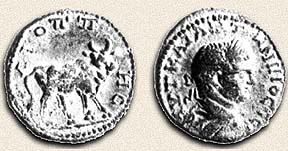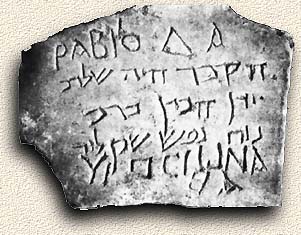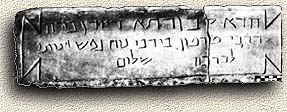
"Roman coin from Caracalla's reign unearthed in Jaffa"

"Roman coin from Caracalla's reign unearthed in Jaffa"
During the time of Roman rule (1st-4th centuries C.E.), Jaffa was called
Joppa Flavia-
named for Flavius Vespasianus, the emperor who put down the Jewish Rebellion.
The
Romans declared it a free city, and permitted it to mint its own coins;
one of the coins found
in Jaffa shows a portrait of Athena, goddess of wisdom, circumscribed by
her full name.
In the 5th-6th centuries C.E. Jaffa came under Byzantine rule, and information
on the city
during that time span is limited.
A bit about the Jewish community in Jaffa from the 1st to the 5th centuries
C.E. can be
learned from the Mishna and Talmud, in which the elders of the city are
mentioned. Another
important source is the ancient cemetery unearthed at nearby Abu Kabir (Giv'at
Herzl)
in 1873 by the French researcher Clermont-Ganneau. In this cemetery, tomb
complexes
were discovered which had been hewn from the local sandstone; in them were
tombstones
bearing inscriptions in Hebrew, Aramaic and Greek. Much can be learned from
these
tombstones about those who dwelt in Jaffa, as well as about other Jewish
communities in
the Land of Israel and the diaspora during the Mishnaic-Talmudic period.
A few tombstones acquired in Jaffa by the Russian Baron Ustinov at the end
of the 1 9th
century were subsequently moved to the Oslo Ethnographic Museum. In 1979,
seven
tombstones from that collection, inscribed in Hebrew and Aramaic, were returned
to Israel.
In the same cemetery, other tombs were excavated over the years, also containing
inscribed tombstones. Two additional burial caves were discovered in 1991
during a
salvage excavation, and a tombstone was found in one of them.
Jaffa was conquered by Muslims in 638 C.E., and between the 7th and 11th
centuries
C.E. was diminished to a small town serving as port to Ramle, the capital;
in the 7th-9th
centuries it was ruled by the Ummayads, in the 10th by the Abbasids, and
in the 11th
century C.E. it was governed by the Fatimid kings.
The Holy Land was conquered by the Crusaders in 1099. Jaffa, which served
as port city
to the Christian capital, Jerusalem, grew and developed. In those days,
like the rest of the
country, it underwent changes in administration in the wake of the wars
which the Muslims
and Crusaders waged against each other. Following the 1187 victory of Salah
ed-Din
(I'Saladin'') in a major battle at the Horns of Hattin in the Galilee, Jaffa
came under Muslim
hegemony, only to be retaken in 1191 by King Richard I ("the Lion-Hearted'l)
of England.
The Crusaders strengthened the city walls and added towers, but with the
reinforcement
of the Muslim forces under the leadership of Egypt's Sultan Baybars 1, the
city once again
fell into Muslim hands (1268); its Christian residents were annihilated,
and its fortifications
destroyed.

"Tombstone from the Jewish cemetery of Jaffa"
"The city of Jaffa was completely demolished, save for two ruined
buildings
which yet remained standing, in which were stationed one officer and several
soldiers to guard the port. But the port, too, was destroyed and obstructed."
Description by a Franciscan monk,
Jaffa, spring of 1347
Jaffa was a small, sparsely populated town for the next 300 years. It served
as a port
of entry for Jewish and Christian pilgrims en route to Jerusalem, and for
goods. This
information came from the testimony of pilgrims, who told of Jaffa's tiny
port and its nearby
caves, used as storehouses for goods and as lodgings for pilgrims. With
the conquest of
the country by the Ottoman Empire, the Port of Jaffa served Ramle, which
remained the
capital as it had been under Arab rule.

"Tabula ansata from the Jewish cemetery of Jaffa"
Only at the beginning of the 18th century did the city begin to recover
and to function as
an urban center; this followed the efforts of the Ottoman government to
step up its control
of the Land of Israel's southern Coastal Plain and restore security to the
port of Jaffa.
The town's commercial activities intensified: ships laden with rice and
sugar came from
Egypt, and vessels sailed to Egypt and the European countries with cargoes
of soap (for
which Jaffa was well known), olive oil, spices and cotton. The harbor and
wharves were
rebuilt, and a mosque and an Armenian khan were constructed (churches had
been built
previously).
Apparently a new city wall was also built in the 18th century. The improvements
in terms of
security and economic conditions brought with them an increase in the number
of residents,
and by mid-18th century Jaffa had replaced Ramle as the country's pivotal
city.
This burst of growth and prosperity was cut short by the power struggle
between the central
Ottoman government and its local governors (1769-1775). Twice Jaffa was
subjugated
after being besieged (1773 and 1775), its agricultural areas laid waste
and many of its
citizens executed.
Jaffa went through other traumas: Napoleon and his army - following a siege
and
prolonged artillery bombardment - breached the city walls in March of 1799
and took
Jaffa out of Turkish hands. At that time, an epidemic of plague broke out
in the city,
and Napoleon poisoned all of his soldiers and prisoners who were infected
by the dread
disease.
After only a few months, Napoleon retreated and returned to Egypt following
his attempt to
conquer Akko (Acre) and his disastrous defeat there. The country was once
again under
Ottoman rule. The governor of Akko, Ahmad Pasha - more commonly known by
his
nickname, al-Jazzar ("the butcher") - revolted against the Ottoman
administration and
conquered Jaffa after nine months of siege (1800). He governed the city
until his death in
1804.
Muhammad Aja Pasha, nicknamed "Abu Nabut," was Governor of Jaffa
from 1810 to 1820
(Abu Nabut - "my father the cudgel"; according to tradition, he
walked the streets of Jaffa
with a billyclub in his hand, instilling fear into the hearts of its residents.)
He carried out construction and extensive renovation in the city. Structures
he built survive until today, among them the al-Mahmudiyya Mosque, a decorative
fountain which has survived in part, and a water fountain for travelers
(sabil) appropriately known as "Sabil Abu Nabut" (at the entrance
to Jaffa, junction of the Gaza and Jerusalem roads). Abu Nabut erected marketplaces
and a seawall (to protect goods);
he repaired the city walls and installed a main gate on their eastern side.
This was a period
of prosperity: the city's population grew, trade flourished, its economic
situation improved,
and the surrounding groves were vastly enlarged .
When Mohammed Ali Pasha, viceroy of Egypt, renounced his allegiance to the
Ottoman
government and his son Ibrahim Pasha controlled the Holy Land, Jaffa surrendered
without
a struggle. Egyptian Muslims settled in Jaffa and its environs, founding-
among others-
the villages of Sakhanat al-Muzariyya (Manshiya) and Sakhanat Abu Kabir
(Giv'at Herzl).
At that time there were vast citrus groves outside the city walls, which
began to fulfill an
important role in Jaffa's economy.
About a decade later, Jaffa returned to Ottoman rule; because of the city's
commendable
economic situation, its population grew-including Sephardic Jewish residents
from
Morocco, Turkey, Greece, Bulgaria and the like, and Ashkenazic Jews from
Central and
Eastern Europe.
As a result of the city's expansion, the need arose to broaden the city
limits. Over a nine
year period (1879-1888), the Ottoman administration demolished the walls,
filling in and
paving their course to make a main thoroughfare around the Old City (today
Yefet Street).
In the adjacent area houses, stores, khans and storehouses were erected.
In the northern part of Jaffa, Jewish residents built the neighborhoods
of Neve Zedek
(1887) and Neve Shalom (1890). At the beginning of the 20th century, Jaffa
was still under
Ottoman rule. At that time there was a significant rise in Jewish immigration
to the Holy
Land, and the lack of dwelling accommodations led to the establishment of
what was then
a suburb - Tel Aviv.
During World War 1, at the time of the struggle between British and Turkish
forces
in Palestine, all the residents of Jaffa (including Jews) who refused to
accept Turkish
nationality were banished. On November 16, 1917, a victorious British army
marched into
Jaffa. The city, like the other parts of the country, passed into the hands
of the British
government, and its citizens returned to reside there once again.
Rapid growth of the Jewish community in Jaffa caused open hostility toward
it on the part
of the city's Arab residents. Anti-Jewish riots by the Arabs in 1920, 1936
and 1939 brought
about a mass exodus of Jaffa's Jews to Tel Aviv. Many buildings in Jaffa
were torn down
by the British to give them greater mobility and better control over the
gangs of rioters.
Close to the time of the British withdrawal from Palestine (April 1948),
the troops of the
two Jewish underground paramilitary organizations, the Haganah and Irgun
Zvai Leumi
("Etzel") began preparing for military action against the Arabs
of Jaffa. First the Etzel
soldiers shelled Jaffa from the area of Neve Shalom. After some difficult
fighting, the
Jewish troops reached the seashore and bisected Jaffa by cutting off the
Manshiya quarter
from the rest of the city. Afterwards Haganah forces captured the main Arab
bases in the
area surrounding Jaffa and encircled the city. On May 14, 1948, the Arabs
of Jaffa signed
a surrender agreement. Two years later, Jaffa and Tel Aviv were united to
become one
city, Tel Aviv-Jaffa.
The Old Jaffa Development Co. Ltd. was established in 1960 with the objective
of
transforming the city's crime-ridden Old Jaffa district into a historical
- artistic-touristic site.